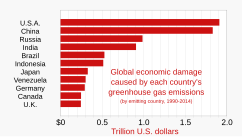
Back انبعاثات الغازات الدفيئة من الصين Arabic Emisiones de gases de efecto invernadero de China Spanish انتشار گازهای گلخانه ای توسط چین Persian 中國溫室氣體排放 Chinese
China's greenhouse gas emissions are the largest of any country in the world both in production and consumption terms, and stem mainly from coal burning, including coal power, coal mining,[3] and blast furnaces producing iron and steel.[4] When measuring production-based emissions, China emitted over 14 gigatonnes (Gt) CO2eq of greenhouse gases in 2019,[5] 27% of the world total.[6][7] When measuring in consumption-based terms, which adds emissions associated with imported goods and extracts those associated with exported goods, China accounts for 13 gigatonnes (Gt) or 25% of global emissions.[8] According to the Carbon Majors Database, Chinese state coal production alone accounts for 14% of historic global emissions.[9]
As of 2019[update], the country's greenhouse gas emissions have exceeded the combined emissions of the developed world.[6][10] However, China's per person emissions have remained considerably lower than those in the developed world.[8] This corresponds to over 10.1 tonnes CO2eq emitted per person each year, slightly over the world average and the EU average but significantly lower than the second largest emitter of greenhouse gases, the United States, with its 17.6 tonnes per person.[8] Accounting for historic emissions, OECD countries produced four times more CO2 in cumulative emissions than China, due to developed countries' early start in industrialization.[6][8] Overall, China is a net exporter of greenhouse emissions.[11]
The targets laid out in China's nationally determined contribution in 2016 will likely be met, but are not enough to properly combat global warming.[12] China has committed to peak emissions by 2030 and net zero by 2060.[13] In order to limit warming to 1.5 degrees C coal plants in China without carbon capture must be phased out by 2045.[14] China continues to build coal-fired power stations in 2020 and promised to "phase down" coal use from 2026.[15] According to various analysis, China is estimated to overachieve its renewable energy capacity and emission reduction goals early, but long-term plans are still required to combat the global climate change and meeting the Nationally Determined Contribution (NDC) targets.[16][17][18]
In 2024, China recorded a 3% decrease in greenhouse gas emissions compared to the previous year. This development suggests that emissions might have peaked sooner than the 2030 target initially set. The reduction was largely attributed to an expansion in wind and solar power capacities, which largely covered the increased demand for electricity, coupled with a downturn in the property sector that resulted in lower emissions from industries like steel and cement manufacturing. However, several challenges remain, including the technical difficulties of integrating solar energy into the existing power grid and a continued dependence on coal, which experienced a 2% increase in use in 2023.[19]
- ^ "Historical GHG Emissions / Global Historical Emissions". ClimateWatchData.org. Climate Watch. Archived from the original on 21 May 2021. ● Population data from "List of the populations of the world's countries, dependencies, and territories". britannica.com. Encyclopedia Britannica. Archived from the original on 26 June 2021.
- ^ Chart based on: Milman, Oliver (12 July 2022). "Nearly $2tn of damage inflicted on other countries by US emissions". The Guardian. Archived from the original on 12 July 2022. Guardian cites Callahan, Christopher W.; Mankin, Justin S. (12 July 2022). "National attribution of historical climate damages". Climatic Change. 172 (40): 40. Bibcode:2022ClCh..172...40C. doi:10.1007/s10584-022-03387-y. S2CID 250430339.
- ^ Cite error: The named reference
:0was invoked but never defined (see the help page). - ^ "Analysis: China's carbon emissions grow at fastest rate for more than a decade". Carbon Brief. 2021-05-20. Archived from the original on 2021-07-27. Retrieved 2021-07-07.
- ^ "Preliminary 2020 Greenhouse Gas Emissions Estimates for China". Rhodium Group. 4 March 2021. Archived from the original on 2021-06-23. Retrieved 2021-04-25.
- ^ a b c "China's Emissions Now Exceed All the Developed World's Combined". Bloomberg News. 6 May 2021. Archived from the original on 2021-11-01. Retrieved 2021-11-01.
- ^ "CO2 Emissions: China - 2020". Climate TRACE. Archived from the original on 2021-11-12. Retrieved 2021-09-27.
- ^ a b c d Larsen, Kate; Pitt, Hannah (6 May 2021). "China's Greenhouse Gas Emissions Exceeded the Developed World for the First Time in 2019". Rhodium Group. Archived from the original on 17 June 2021. Retrieved 1 November 2021.
- ^ Cite error: The named reference
:5was invoked but never defined (see the help page). - ^ Cite error: The named reference
:9was invoked but never defined (see the help page). - ^ Ritchie, Hannah (7 October 2019). "How do CO2 emissions compare when we adjust for trade?". Our World in Data. Archived from the original on 12 June 2023. Retrieved 18 July 2023.
- ^ "To prevent catastrophic global warming, China must hang tough". The Economist. 2019-09-19. ISSN 0013-0613. Archived from the original on 2019-10-04. Retrieved 2019-10-04.
- ^ "China aims to cut its net carbon-dioxide emissions to zero by 2060". The Economist. ISSN 0013-0613. Archived from the original on 2021-07-29. Retrieved 2020-09-29.
- ^ China's New Growth Pathway: From the 14th Five-Year Plan to Carbon Neutrality (PDF) (Report). Energy Foundation China. December 2020. p. 24. Archived from the original (PDF) on 2021-04-16. Retrieved 2020-12-16.
- ^ "Why China's climate policy matters to us all". BBC News. 2021-08-08. Archived from the original on 2022-03-12. Retrieved 2021-10-03.
- ^ "China on Track to Blow Past Xi's Clean Power Goal Five Years Early". Bloomberg News. 28 June 2023. Archived from the original on 2023-07-04. Retrieved 2023-07-18.
- ^ "China's CO2 emissions fall but policies still not aligned with long-term goals". Reuters. 21 November 2022. Archived from the original on 2023-10-11. Retrieved 2023-07-18.
- ^ "China Climate Action". Climate Action Tracker. Archived from the original on 2021-05-15. Retrieved 2023-07-18.
- ^ "China's Falling Emissions Signal Peak Carbon May Already Be Here". Bloomberg News. May 28, 2024. Retrieved 2024-05-28.
© MMXXIII Rich X Search. We shall prevail. All rights reserved. Rich X Search

